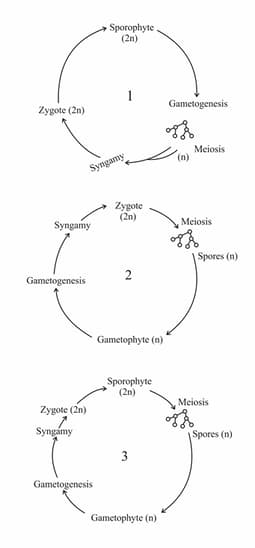EASY
Earn 100
The life cycle of some plants do not involve a free-living sporophyte and the dominant, photosynthetic phase is the free-living gametophyte. This type of life cycle is called
(a)the Haplo-diplontic life cycle and it is seen in kelp.
(b)the Haplontic life cycle which is seen in Volvox and some species of Chlamydomonas.
(c)the Diplontic life cycle which is seen in seed-bearing plants.
(d)the Haplo-diplontic life cycle which is seen in bryophytes and pteridophytes.
50% studentsanswered this correctly
Important Questions on Plant Kingdom
MEDIUM
EASY
EASY
MEDIUM
Based on the following characteristics of life cycles identify and arrange the plants respectively.
| A) Haplontic | i) Laminaria |
| B) Diplo-haplontic | ii) Volvox |
| C) Haplo-diplontic | iii) Polysiphonia |
| D) Diplobiontic | iv) Salvinia |
| E) Diplontic | v) Fucus |
MEDIUM
A. Independent one-celled or many-celled gametophytes.
B. Multicellular dependent sporophyte.
C. One or few celled dependent gametophytes.
D. Reduced sporophyte as 1-celled structure.
These statements are correct for which group of plants?
MEDIUM
MEDIUM

EASY
EASY
MEDIUM
EASY
Reason: Zygotic meiosis occurs in Spirogyra.
MEDIUM
EASY
EASY
Which of these have diplontic life cycle?
MEDIUM
EASY
HARD
A. Femur - Longest bone in human body.
B. Coxal - Formed by the fusion of three bones ilium, ischium and pubis.
C. Hyoid - A single U-shaped bone at the base of buccal cavity.
D. Scapula - Large triangular flat bone situated in the ventral part of the thorax between the second andseventh rib.
E. Occipital bone - Possess obturator foramen for the exit of spinal cord.
EASY
EASY

